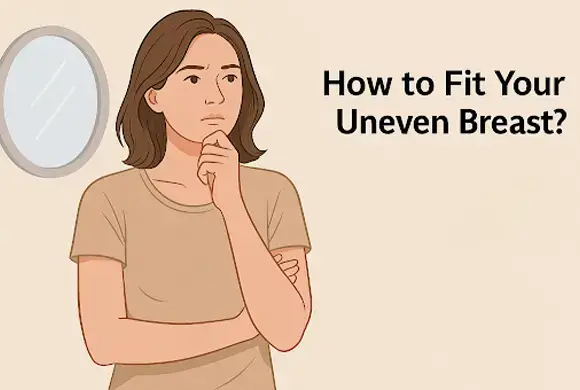Why Do Women Have Uneven Breasts?
1. Normal Development and Genetics
- Puberty: During adolescence, breasts don’t always develop at the same pace. One side may grow faster, leaving a temporary or sometimes permanent difference in size.
- Anatomical variations: Just like eyebrows, hands, or feet aren’t perfectly identical, breasts naturally vary a little. A small difference is completely normal and part of your genetic makeup.
2. Hormonal Changes
- Menstrual cycle: Hormone levels rise and fall throughout the month. This can cause swelling and sensitivity in the breasts, sometimes more on one side than the other.
- Pregnancy and breastfeeding: Hormones during pregnancy stimulate breast growth, but one side may respond more strongly. Later, babies often prefer one breast for feeding, making it fuller than the other. These changes are usually temporary but can leave a lasting difference for some women.
- Menopause: As oestrogen levels decline, breast tissue shrinks and changes. One side may reduce faster than the other, leading to unevenness.
3. Weight Fluctuations
Breasts are mostly fatty tissue. Gaining or losing weight can change their size and shape and it’s not uncommon for one breast to be affected more than the other.4. Benign Breast Conditions
Non-cancerous issues such as cysts, fibrous tissue growth, or fat necrosis (from injury) can cause swelling or lumps that make one breast look different.5. Medical Conditions
In rare cases, congenital conditions lead to more noticeable asymmetry:- Poland syndrome: The chest muscle doesn’t fully develop on one side, making the breast appear smaller.
- Juvenile hypertrophy: One breast grows excessively during puberty, while the other remains smaller.
6. Trauma or Surgery
An injury to the chest—especially during childhood—or surgical procedures like a lumpectomy, mastectomy, or radiation therapy can change breast size and shape.7. Posture and Lifestyle Habits
Long-term habits such as slouching, sleeping predominantly on one side, or carrying heavy bags on one shoulder can affect how breasts sit on the chest, exaggerating natural differences.8. Exercise and Muscle Development
Sports or gym workouts that build chest muscles (like tennis, swimming, or weightlifting) can cause uneven pectoral development. This doesn’t change the breast tissue itself but can make one breast appear higher or fuller.9. Natural Ageing Process
Over time, gravity, skin elasticity and ligament strength affect each breast slightly differently. As a result, one breast may sag or lose volume faster than the other.10. Skin and Connective Tissue Health
Factors like rapid weight loss, sun damage, or certain connective tissue conditions can reduce elasticity unevenly, making one breast droop more than the other.11. Medications and Hormone Therapy
Long-term hormonal treatments, such as birth control, fertility medications, or hormone replacement therapy, can cause uneven breast changes—especially if one side is more hormonally sensitive.12. Perception and Visual Differences
Sometimes the asymmetry is less significant than it feels. Lighting, posture, or viewing angle can exaggerate the difference. Many women believe their breasts are “very uneven”, when in reality, the variation is small and hardly noticeable to others.Challenges Women Face with Uneven Breasts
How to Fit a Bra for Uneven Breasts (Step-by-Step Guide)
Uneven breasts don’t have to mean uneven confidence. The secret is to focus on balance rather than perfection. With the right adjustments, your bra can support both sides beautifully. Here’s how you can do it:Start With the Larger Breast
Create Harmony With Padding
Play With Strap Adjustments
Opt for Forgiving Fabrics
Test Different Styles Before Deciding
Best Bra Styles for Uneven Breasts
Certain bra styles are more forgiving and supportive when you’re dealing with asymmetry. Here are some of the best options:- T-shirt bras with removable padding – Let you customise each side.
- Balconette bras – Provide great shape and lift without drawing attention to unevenness.
- Bralettes – Stretchy and comfortable, perfect for mild differences.
- Custom-fit or dual-size bras – Designed for women with a noticeable cup difference.
Tips for Bra Shopping with Uneven Breasts
Shopping for bras when you have uneven breasts doesn’t have to feel intimidating. Keep these tips in mind:- Look for bras with removable cups or inserts—they give you flexibility.
- Ask for professional help—fitters see this often and can give great advice.
- Don’t stress over size labels—comfort is more important than the number on the tag.
- Be open to different brands and styles—sometimes the unexpected works best.
